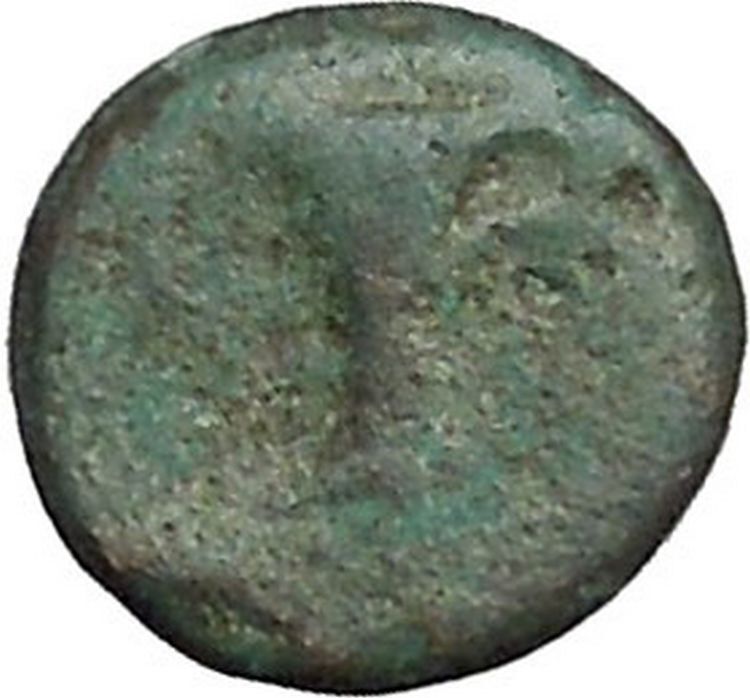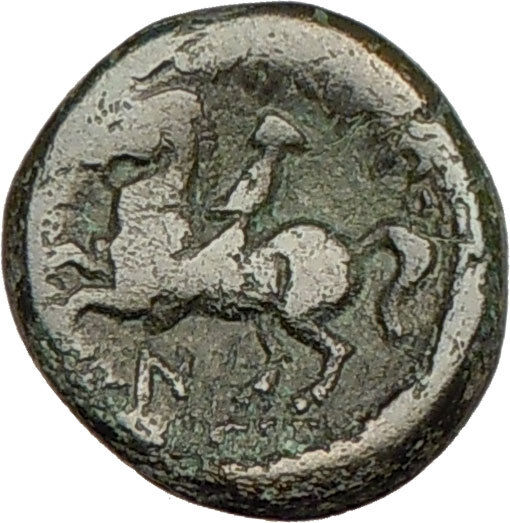|
Greek city of Tauromenion in Sicily
Bronze 23mm (11.60 grams) Struck circa 207-200/190 B.C.
Reference: HGC 2, 1582; Campana 27; BAR Issue 16; CNS 25
Certification: NGC Ancients Ch F 4934590-005
Laureate head of Apollo left; bee to right.
TAYPOMENITAN, Tripod.
You are bidding on the exact item pictured, provided with a Certificate of Authenticity and Lifetime Guarantee of Authenticity.
 In Greek and Roman mythology, Apollo, is one of the most important and diverse of the Olympian deities. The ideal of the kouros (a beardless youth), Apollo has been variously recognized as a god of light and the sun; truth and prophecy; archery; medicine and healing; music, poetry, and the arts; and more. Apollo is the son of Zeus and Leto, and has a twin sister, the chaste huntress Artemis. Apollo is known in Greek-influenced Etruscan mythology as Apulu. Apollo was worshiped in both ancient Greek and Roman religion, as well as in the modern Greco-Roman Neopaganism. In Greek and Roman mythology, Apollo, is one of the most important and diverse of the Olympian deities. The ideal of the kouros (a beardless youth), Apollo has been variously recognized as a god of light and the sun; truth and prophecy; archery; medicine and healing; music, poetry, and the arts; and more. Apollo is the son of Zeus and Leto, and has a twin sister, the chaste huntress Artemis. Apollo is known in Greek-influenced Etruscan mythology as Apulu. Apollo was worshiped in both ancient Greek and Roman religion, as well as in the modern Greco-Roman Neopaganism.
As the patron of Delphi (Pythian Apollo), Apollo was an oracular god – the prophetic deity of the Delphic Oracle. Medicine and healing were associated with Apollo, whether through the god himself or mediated through his son Asclepius, yet Apollo was also seen as a god who could bring ill-health and deadly plague as well as one who had the ability to cure. Amongst the god’s custodial charges, Apollo became associated with dominion over colonists, and as the patron defender of herds and flocks. As the leader of the Muses (Apollon Musagetes) and director of their choir, Apollo functioned as the patron god of music and poetry. Hermes created the lyre for him, and the instrument became a common attribute of Apollo. Hymns sung to Apollo were called paeans.
In Hellenistic times, especially during the third century BCE, as Apollo Helios he became identified among Greeks with Helios, god of the sun, and his sister Artemis similarly equated with Selene, goddess of the moon. In Latin texts, on the other hand, Joseph Fontenrose declared himself unable to find any conflation of Apollo with Sol among the Augustan poets of the first century, not even in the conjurations of Aeneas and Latinus in Aeneid XII (161-215). Apollo and Helios/Sol remained separate beings in literary and mythological texts until the third century CE.
Taormina (Sicilian: Taurmina, Greek: Ταυρομένιον Tauromenion, Latin: Tauromenium) is a comune and small town on the east coast of the island of Sicily, Italy, in the Province of Messina, about midway between Messina and Catania. Taormina has been a very popular tourist destination since the 19th century. It has popular beaches (accessible via an aerial tramway) on the Ionian sea, which is remarkably warm and has a high salt content. Taormina can be reached via highways (autostrade) from Messina from the north and Catania from the south.
History
Ancient
The area around Taormina was inhabited by the Siculi even before the Greeks arrived on the Sicilian coast in 734 BC to found a town called Naxos. The theory that Tauromenion was founded by colonists from Naxos is confirmed by Strabo and other ancient writers.
The new settlement seems to have risen rapidly to prosperity, and was apparently already a considerable town at the time of Timoleon’s expedition in 345 BC. It was the first place in Sicily where that leader landed, having eluded the vigilance of the Carthaginians, who were guarding the Straits of Messina, and crossed direct from Rhegium (modern Reggio di Calabria) to Tauromenium. The city was at that time still under the government of Andromachus, whose mild and equitable administration is said to have presented a strong contrast with that of the despots and tyrants of the other Sicilian cities. He welcomed Timoleon with open arms, and afforded him a secure resting place until he was enabled to carry out his plans in other parts of Sicily. Andromachus was not deprived of his position of power when all the other tyrants were expelled by Timoleon, but was permitted to retain it undisturbed till his death. (Marcellin. Vit. Thucyd. § 27.)
Little is recorded about Tauromenium for some time after this. It is probable that it passed under the authority of Agathocles, who drove the historian Timaeus into exile; and some time after this it was subject to a domestic despot of the name of Tyndarion, who was contemporary with Hicetas of Syracuse and Phintias of Agrigentum. Tyndarion was one of those who concurred in inviting Pyrrhus into Sicily (278 BC), and when that monarch landed with his army at Tauromenium, joined him with all his forces, and supported him in his march upon Syracuse. A few years later we find that Tauromenium had fallen into the power of Hieron of Syracuse, and was employed by him as a stronghold in the war against the Mamertines. (Id. p. 497.) It was also one of the cities which was left under his dominion by the treaty concluded with him by the Romans in 263 BC.

Taormina as seen from the Saracen castle overlooking the town. The Greek amphitheatre is visible in the distance.
There is no doubt that Tauromenium continued to form a part of the kingdom of Syracuse until the death of Hieron, and that it only passed under the government of Rome when the whole island of Sicily was reduced to a Roman province; but we have scarcely any account of the part it took during the Second Punic War, though it would appear, from a hint in Appian,[6] that it submitted to Marcellus on favorable terms; and it is probable that it was on that occasion it obtained the peculiarly favored position it enjoyed under the Roman dominion. For we learn from Cicero that Tauromenium was one of the three cities in Sicily which enjoyed the privileges of a civitas foederata or allied city, thus retaining a nominal independence, and was not even subject, like Messina, to the obligation of furnishing ships of war when called upon. The city, however, suffered severe calamities during the Servile War in Sicily (134-132 BC), having fallen into the hands of the insurgent slaves, who, on account of the great strength of its position, made it one of their chief posts, and were able for a long time to defy the arms of the consul Publius Rupilius. They held out until they were reduced to the most fearful extremities by famine, when the citadel was at length betrayed into the hands of the consul by one of their leaders named Sarapion, and the whole of the survivors put to the sword.
Tauromenium again played a conspicuous part during the wars of Sextus Pompeius in Sicily, and, from its strength as a fortress, was one of the principal points of the position which he took up in 36 BC, for defence against Octavian. It became the scene also of a sea-fight between a part of the fleet of Octavian, commanded by the triumvir in person, and that of Pompeius, which terminated in the defeat and almost total destruction of the former. In the settlement of Sicily after the defeat of Pompeius, Tauromenium was one of the places selected by Augustus to receive a Roman colony, probably as a measure of precaution, on account of the strength of its situation, as we are told that he expelled the former inhabitants to make room for his new colonists. Strabo speaks of it as one of the cities on the east coast of Sicily that was still subsisting in his time, though inferior in population both to Messana and Catana. Both Pliny and Ptolemy assign it the rank of a colonia, and it seems to have been one of the few cities of Sicily that continued under the Roman Empire to be a place of some consideration. Its territory was noted for the excellence of its wine, and produced also a kind of marble which seems to have been highly valued. Juvenal also speaks of the sea off its rocky coast as producing the choicest mullets. (Juv. v. 93.) The Itineraries place Tauromenium 32 miles from Messina, and the same distance from Catania. (Itin. Ant. p. 90; Tab. Peut.)
Middle ages and modern era
After the fall of the Western Roman Empire, Taormina continued to rank as one of the more important towns of Sicily, and because of the strength of its position was one of the last places that was retained by the Eastern Roman emperors; but it was taken by the Arabs in 902 after a siege of two years. Taormina was renamed “Al-Muizzia” in honour of Imam al-Muizz, who was a Fatimid Caliph (reigned 953-75). Muslim rule of the town (see History of Islam in southern Italy) lasted until 1078, when it was captured by the Norman count Roger I of Sicily.
After the fall of the Normans and of their heirs, the Hohenstaufen, Taormina followed the history of Sicily under the Angevins and then the Crown of Aragon. In 1410 King Martin II of Sicily was elected here by the Sicilian Parliament. Later Taormina was under Spanish suzerainty, receiving the status of “city” in the 17th century.
In 1675 it was besieged by the French, who had occupied Messina. Under the Bourbons dynasty of the Kingdom of Two Sicilies, Taormina did not have a relevant role; however, it obtained an easier access when part of the Catrabico promontory was partially cut and a seaside road connecting it to Messina and Catania was created. It received also a station on the second-oldest railroad in the region. Starting from the 19th century Taormina became a popular tourist resort in the whole of Europe: people who visited Taormina include Oscar Wilde, Nicholas I of Russia, Johann Wolfgang von Goethe, Nietzsche (who here wrote his Also sprach Zarathustra), Richard Wagner and many others.
|









 In Greek and Roman mythology, Apollo, is one of the most important and diverse of the Olympian deities. The ideal of the kouros (a beardless youth), Apollo has been variously recognized as a god of light and the sun; truth and prophecy; archery; medicine and healing; music, poetry, and the arts; and more. Apollo is the son of Zeus and Leto, and has a twin sister, the chaste huntress Artemis. Apollo is known in Greek-influenced Etruscan mythology as Apulu. Apollo was worshiped in both ancient Greek and Roman religion, as well as in the modern Greco-Roman Neopaganism.
In Greek and Roman mythology, Apollo, is one of the most important and diverse of the Olympian deities. The ideal of the kouros (a beardless youth), Apollo has been variously recognized as a god of light and the sun; truth and prophecy; archery; medicine and healing; music, poetry, and the arts; and more. Apollo is the son of Zeus and Leto, and has a twin sister, the chaste huntress Artemis. Apollo is known in Greek-influenced Etruscan mythology as Apulu. Apollo was worshiped in both ancient Greek and Roman religion, as well as in the modern Greco-Roman Neopaganism.





